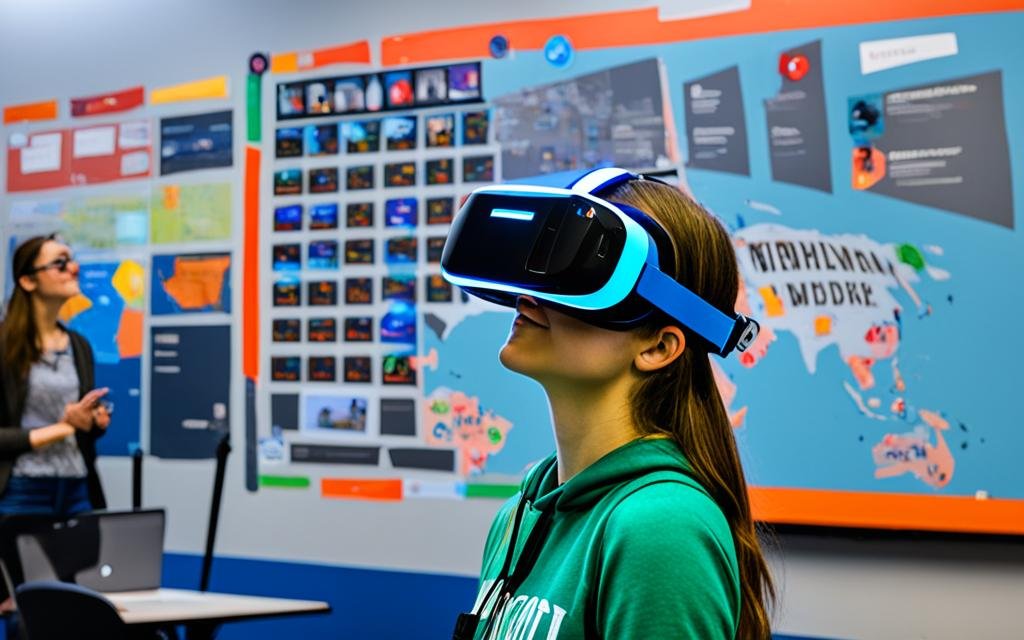Virtual reality (VR) technology is rapidly transforming the landscape of language education, offering unparalleled immersion and engagement for learners. This cutting-edge technology simulates computer-generated environments, allowing users to experience a sense of presence and interact with virtual objects and surroundings. As VR becomes more affordable and accessible, its adoption in education is likely to grow, revolutionizing the way language skills are cultivated. By blending VR’s immersive capabilities with innovative teaching methodologies, educators can create a transformative Language Education Journey that empowers students to develop fluency, cultural awareness, and confidence in a dynamic, interactive setting.
Key Takeaways
- Virtual reality technology is transforming language education, offering unparalleled immersion and engagement for learners.
- VR simulates computer-generated environments, allowing users to experience a sense of presence and interact with virtual objects.
- Blending VR’s immersive capabilities with innovative teaching methodologies can create a transformative Language Education Journey.
- VR’s adoption in education is likely to grow, revolutionizing the way language skills are cultivated.
- Educators can leverage VR to empower students to develop fluency, cultural awareness, and confidence in a dynamic, interactive setting.
Current State of VR in Education
The integration of Virtual Reality (VR) in education is ushering in a transformative era for language learners. A recent study by PwC found that VR learners were 4 times faster to train than in the classroom, 275% more confident to apply skills learned after training, and 3.75 times more emotionally connected to content than classroom learners. This remarkable performance advantage highlights the immense potential of VR to revolutionize the language education journey.
VR Learners’ Performance Advantages
As the metaverse continues to expand, VR is unlikely to completely replace traditional classroom training or online learning in the near future. However, incorporating VR learning into a blended learning approach can significantly enhance the language education experience. VR can provide immersive simulations that allow students to experience real-world scenarios in a safe and controlled environment, transport them to different time periods and cultures, and facilitate virtual field trips and tours to enhance experiential learning.
Blended Learning with VR
The applications of VR in education are vast and diverse, catering to the diverse needs of language learners. VR can simulate real-world situations, enabling students to engage in conversations, listen to native speakers, and explore cultural nuances, providing a transformative language learning journey. Additionally, VR can enhance vocabulary acquisition by exposing learners to words and phrases in realistic, immersive environments, and boost learners’ confidence by offering a less intimidating space for practice and immediate feedback.
Applications of VR in Education
By harnessing the power of VR, language educators can create engaging, interactive, and personalized learning experiences that cater to the diverse needs and preferences of their students. As the metaverse continues to evolve, the integration of VR in language education will become increasingly prevalent, paving the way for a future where multilingual development, linguistic diversity, and cross-cultural communication are seamlessly woven into the language education journey.
Unleashing VR’s Potential in Language Learning
Virtual Reality in language education introduces students to immersive, virtual environments that significantly enhance engagement and facilitate skill practice in realistic settings. This innovative approach transforms traditional teaching methodologies, offering a broader spectrum of learning opportunities that resonate with the digital age’s trends.
Immersive Learning Environments
VR’s immersive learning environments allow students to experience language use in varied real-life situations, boosting their engagement and motivation. By simulating real-life scenarios, learners can engage in conversations, listen to native speakers, and explore cultural nuances, providing a transformative language learning journey.
Enhancing Engagement and Motivation
The captivating nature of virtual reality environments can significantly enhance learners’ engagement and motivation. By offering a more dynamic and interactive way to practice language skills, VR can foster a deeper sense of immersion and connection with the target language and culture.
Simulating Real-Life Scenarios
VR’s ability to simulate real-life scenarios enables language learners to apply their skills in practical contexts, bridging the gap between classroom instruction and real-world communication. This approach allows students to engage in authentic dialogues, navigate cultural differences, and develop a more comprehensive understanding of the language.
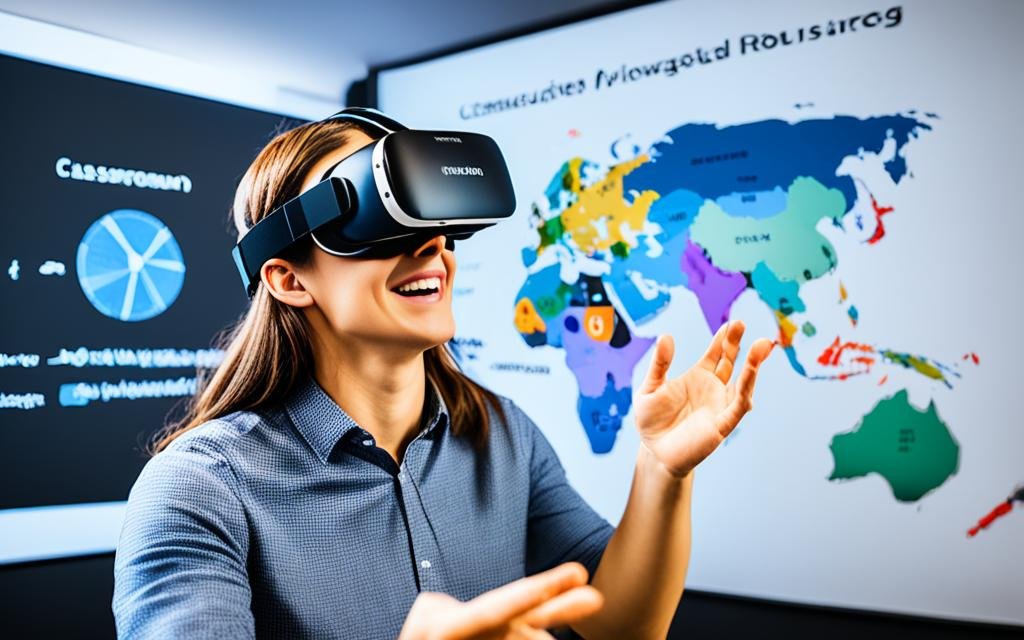
The Growing Popularity of VR in English Teaching
Virtual Reality (VR) and Augmented Reality (AR) are transforming the way English is taught, making the learning process more engaging and immersive for students. VR in English teaching encompasses a wide range of digital experiences, from fully immersive virtual environments to blended AR solutions that seamlessly integrate digital components with the real world. This innovative approach to language education introduces learners to the English language in a fun, captivating manner, fostering a deeper connection with the subject matter.
The benefits of employing VR in English teaching are manifold. VR can enhance vocabulary acquisition by exposing students to words and phrases in realistic, contextual settings, helping them to better retain and apply the language. Furthermore, the immersive learning experiences facilitated by VR can significantly improve students’ listening and speaking skills, as they engage in conversations, interact with virtual objects, and explore cultural nuances within the simulated environments.
As VR technology continues to evolve and become more accessible, its integration into language education is likely to become increasingly prevalent. This transformation will redefine the language education journey, empowering students to acquire and practice their English proficiency in ways that were once inconceivable. By leveraging the power of virtual and augmented reality, educators can create a more engaging, interactive, and personalized learning experience that resonates with the digital-savvy generation of today.
Language Education Journey
The Language Education Journey facilitated by VR technology offers a multifaceted approach to language learning. VR’s rich, contextual settings help learners absorb new vocabulary more naturally, as they are exposed to words and phrases in realistic, immersive environments.
Vocabulary Enhancement
VR’s ability to create immersive, contextual settings allows learners to assimilate new vocabulary more organically. By encountering words and expressions in realistic scenarios, students can better understand their meanings and usage, enhancing their language education journey.
Immersive Cultural Experiences
Additionally, VR can transport students to diverse cultural settings, allowing them to experience language use within authentic cultural contexts. This exposure heightens their understanding of linguistic nuances and cultural norms, enriching their language learning strategies and fostering a deeper appreciation for multilingual development.
Confidence Building
By providing a less intimidating space for practice, VR can also boost learners’ confidence as they engage in conversations and receive immediate feedback. This approach helps reduce language anxiety and fosters a sense of accomplishment, empowering students to confidently explore the linguistic diversity and cross-cultural communication that are essential to their language education journey.
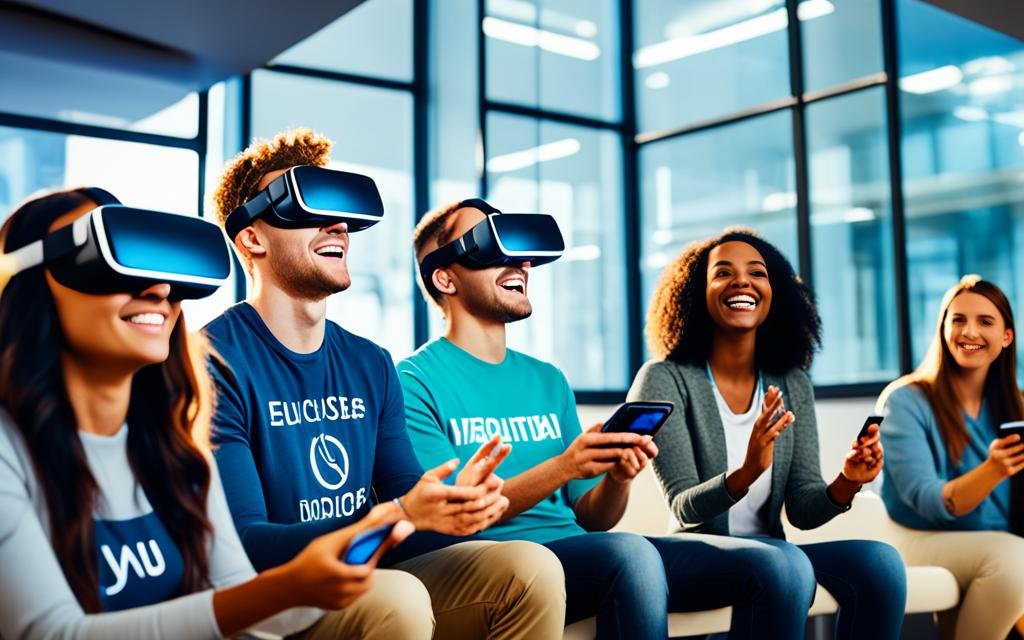
Benefits of VR in Learning Environments
The integration of Virtual Reality (VR) technology into language education has unlocked a multitude of benefits that enhance the learning experience for students. One of the key advantages is the ability to provide an
experiential and interactive learning
environment. VR allows learners to actively engage with virtual objects and scenarios, fostering a hands-on approach to language acquisition. This “learn by doing” approach immerses students in realistic situations, enabling them to practice and apply their language skills in a captivating and immersive setting.
Experiential and Interactive Learning
VR technology creates a captivating experience where learners can interact with virtual objects and scenarios, augmenting their understanding of complex language concepts. By simulating real-life situations, students can engage in conversations, listen to native speakers, and explore cultural nuances, providing a transformative language education journey that resonates with the digital age’s trends.
Real-Time Feedback and Assessment
VR systems offer the unique advantage of providing real-time feedback and assessment within the virtual environment. These systems track students’ actions, responses, and performance, offering immediate guidance to help them identify and rectify mistakes. This instantaneous feedback loop allows learners to refine their language skills and gain a deeper understanding of their progress, enhancing their language learning strategies and language acquisition methods.
Accessibility and Inclusivity
One of the most significant benefits of VR in language education is its ability to promote accessibility and inclusivity. Learners can access educational materials and experiences anywhere in the world, ensuring that no one is left behind in the pursuit of multilingual development and cross-cultural communication. This level of accessibility empowers students of diverse backgrounds and learning needs to engage with language content in a manner that caters to their individual preferences and abilities.
Virtual Reality Challenges and Considerations
As the language education journey continues to evolve, the integration of Virtual Reality (VR) technology in educational settings presents both opportunities and challenges that must be addressed for successful implementation. Educators and administrators must carefully consider various factors to ensure that VR content aligns with the curriculum and learning objectives while providing a cost-effective, scalable solution.
Defining Learning Objectives
The first step in successfully integrating VR into language education is to clearly define the specific learning objectives that the technology aims to support. By identifying the desired outcomes, educators can then select or create VR content that directly addresses the needs of their students and the language skills they seek to develop, such as vocabulary enhancement, cultural immersion, or confidence building.
Curriculum Integration
Seamlessly integrating VR content into the existing curriculum is crucial for its effective adoption. Educators must carefully analyze the relevant subject areas and topics where VR can enhance student learning, ensuring a cohesive and complementary approach that reinforces the language education journey. This process may involve aligning VR experiences with specific lesson plans, assessments, and learning activities.
Cost-Effective Solutions
One of the primary challenges in implementing VR in language education is the cost of the hardware and software required. Educators must explore cost-effective VR solutions that provide a high-quality, immersive experience without straining the educational institution’s budget. This may involve seeking partnerships with technology providers, exploring grant funding opportunities, or considering the use of mobile devices and bring-your-own-device (BYOD) strategies to supplement VR equipment.
Pilot Testing and Iteration
Before rolling out VR content on a larger scale, it is essential to conduct pilot testing with a small group of students or educators. This approach allows for the evaluation of the VR content’s effectiveness, the identification of any technical or logistical challenges, and the collection of valuable feedback from the target audience. Based on the insights gained, educators can then refine and iterate the VR content to ensure its relevance, effectiveness, and alignment with the language education journey.
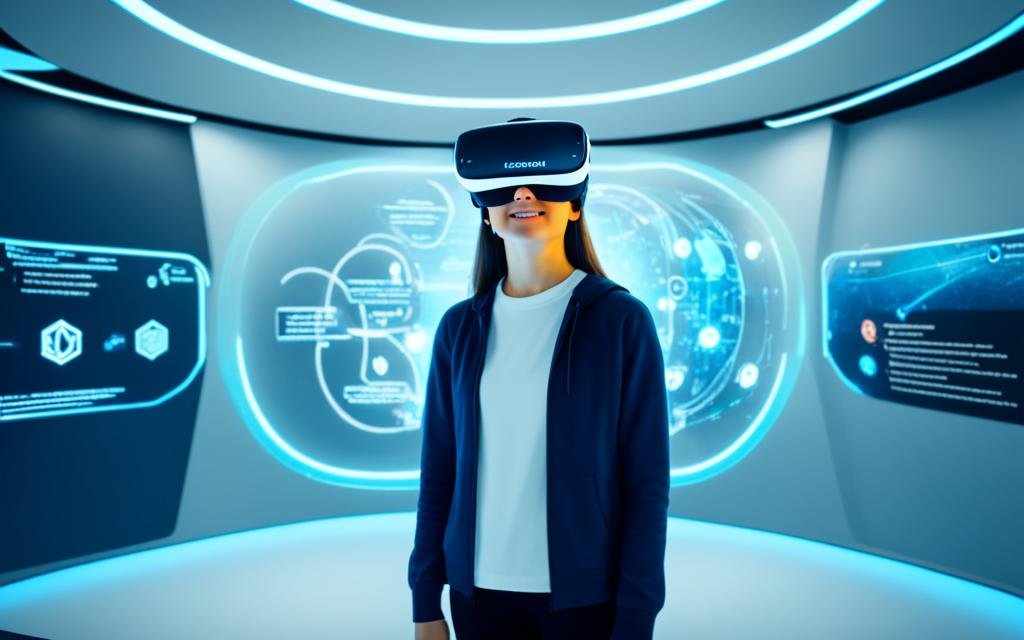
By addressing these challenges and considerations, educators can pave the way for the successful integration of Virtual Reality in the language education journey, unlocking the transformative potential of this innovative technology and empowering students to excel in their linguistic and cultural exploration.
Preparing Educators for VR Integration
Preparing educators to effectively integrate VR into their teaching practices is essential for the successful adoption of this technology in language education. Pedagogical training can help teachers explore how VR aligns with the learning goals of their curriculum and identify the appropriate pedagogical strategies, such as gamification, cooperative learning, and inquiry-based learning, to leverage the full potential of VR.
Pedagogical Training
Educators should be equipped with the knowledge and skills to seamlessly incorporate VR into their language learning strategies. Through comprehensive pedagogical training, teachers can learn how to design immersive learning environments that engage students, foster cultural exposure, and cultivate multilingual development.
Content Creation and Customization
In addition to pedagogical training, educators should also be empowered to create or customize VR content that supports specific topics or concepts in their language curriculum. This hands-on approach allows teachers to align the VR experiences with their educational linguistics and language acquisition methods, ensuring a tailored and effective language education journey for their students.
Collaborative Platforms
Collaborative platforms that enable teachers to share resources, best practices, and lesson plans can further facilitate the integration of VR in language education. By fostering a community of practice, educators can learn from each other’s experiences, adapt successful strategies, and collectively push the boundaries of cross-cultural communication and language exploration through immersive VR technologies.
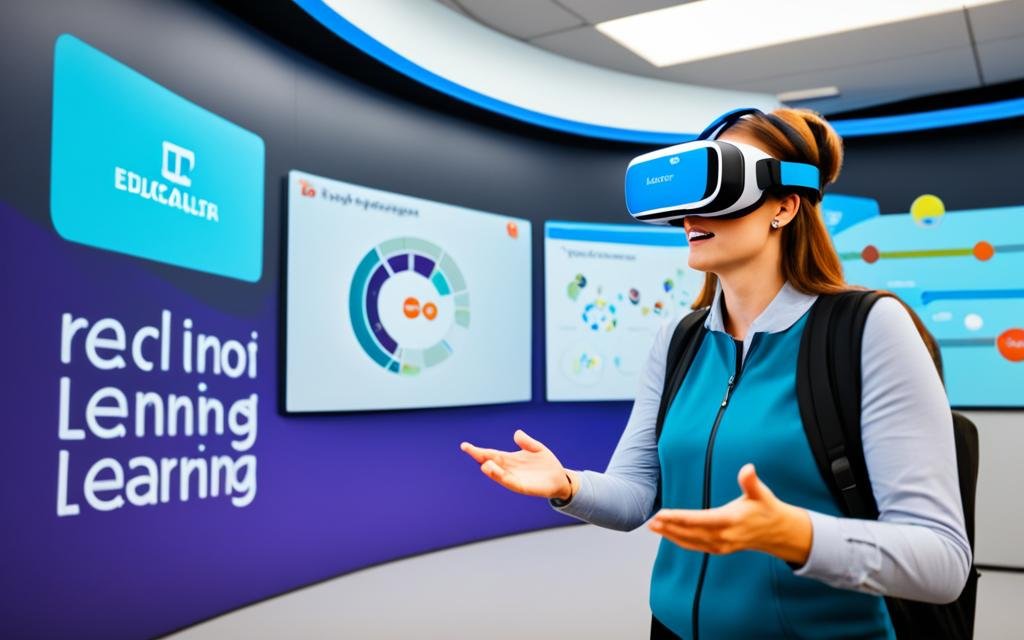
The Role of Generative AI in Language Education
Generative AI plays a pivotal role in shaping the future of language education by offering personalized learning experiences tailored to individual students’ needs and preferences. Powered by advanced machine learning algorithms, Generative AI can create dynamic content, adapt learning materials in real-time, and provide instant feedback and assistance to students.
Personalized Learning Paths
This level of personalization ensures that learners receive the right level of challenge and support, preventing boredom or frustration. Generative AI can adapt the learning materials and activities based on each student’s language proficiency, learning style, and progress, creating a tailored language education journey that maximizes their engagement and learning outcomes.
Instant Feedback and Assistance
Generative AI-powered systems can provide students with instant feedback on their language skills, identifying areas for improvement and offering personalized guidance and support. This real-time feedback loop allows learners to quickly address their weaknesses, fostering a deeper understanding of language learning strategies and language acquisition methods.
Optimizing Learning Resources
Moreover, Generative AI can optimize learning resources based on student interactions, making the content more engaging and effective. By analyzing learner data and preferences, Generative AI can curate and adapt educational materials to better align with the cultural exposure and linguistic diversity of the learners, enhancing their cross-cultural communication and multilingual development.
Accessibility and Inclusivity
By enhancing accessibility and inclusivity, Generative AI can also make high-quality language learning accessible to a broader audience, including students with diverse learning needs. This can promote educational linguistics and language exploration, ensuring that all learners have the opportunity to embark on a transformative language education journey.
VR and AR: Redefining the Learning Experience
Virtual Reality (VR) and Augmented Reality (AR) are transforming the educational landscape, redefining the way students experience and engage with language learning. VR technology immerses learners in computer-generated, three-dimensional environments, allowing them to interact with virtual objects and scenarios. This level of immersion can significantly enhance engagement, motivation, and the application of language skills in realistic contexts.
Virtual Reality (VR)
VR technology offers a captivating and immersive learning experience, transporting students to virtual environments where they can practice language skills in realistic simulations. By engaging with virtual characters, navigating through digital scenes, and responding to various scenarios, learners can develop their language proficiency, cultural awareness, and cross-cultural communication abilities.
Augmented Reality (AR)
Augmented Reality (AR), on the other hand, overlays digital information on the physical world, providing learners with additional context and information to supplement their understanding of language concepts. AR can enhance language learning by integrating virtual elements, such as vocabulary flashcards, interactive grammar exercises, or virtual language tutors, into the real-world environment, creating a blended learning experience.
Potential and Growth of VR and AR
As VR and AR technologies continue to evolve and become more accessible, their potential to revolutionize language education will continue to grow, offering unprecedented opportunities for learners to explore, practice, and master language proficiency. From immersive cultural experiences to personalized language learning pathways, the integration of these cutting-edge technologies will redefine the language education journey, empowering students to acquire and apply language skills in dynamic, engaging, and transformative ways.
Teaching Methodologies: Closed and Open Learning
When integrating VR and AR into language education, two distinct teaching methodologies emerge: the closed learning system and the open learning system. The closed learning system utilizes VR headsets, which completely immerse students in a virtual environment, allowing them to focus solely on the subject matter without external distractions.
Closed Learning System (VR Headsets)
This approach has advantages, such as the ability to connect theory and practice, incorporate gamification elements, and provide a personalized language education journey. However, it also poses challenges, such as the risk of student alienation from real-world social interactions and the potential for VR to limit decision-making and critical thinking.
Open Learning System (AR Solutions)
In contrast, the open learning system leverages AR solutions, which augment the physical world with digital information, providing a more blended learning experience that integrates technology seamlessly with the real-world environment. This approach can enhance language learning strategies, immersion techniques, and cultural exposure, while maintaining a connection to the physical world and promoting multilingual development, linguistic diversity, and cross-cultural communication.
Conclusion
The integration of Virtual Reality (VR) and Augmented Reality (AR) into language education presents an unprecedented opportunity to revolutionize the way students learn and acquire language proficiency. By harnessing the immersive, interactive, and personalized capabilities of these technologies, educators can create transformative language learning experiences that captivate students, enhance engagement, and foster a deeper understanding of language and culture.
As the future of education continues to evolve, the seamless integration of VR, AR, and Generative AI will redefine the Language Education Journey, empowering learners to navigate the linguistic and cultural complexities of our interconnected world with confidence and success. The multilingual development and cross-cultural communication skills fostered through these innovative language acquisition methods will become increasingly valuable in a globally connected world.
The future of language education is here, and it is fueled by the boundless possibilities of virtual and augmented reality. By embracing these educational linguistics and immersion techniques, we can unlock new doors of linguistic diversity and cultural exposure, ultimately transforming the language education journey for generations to come.
